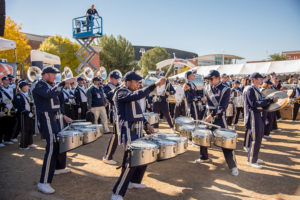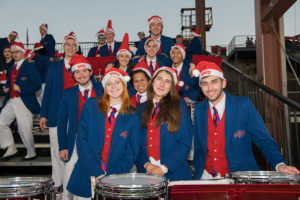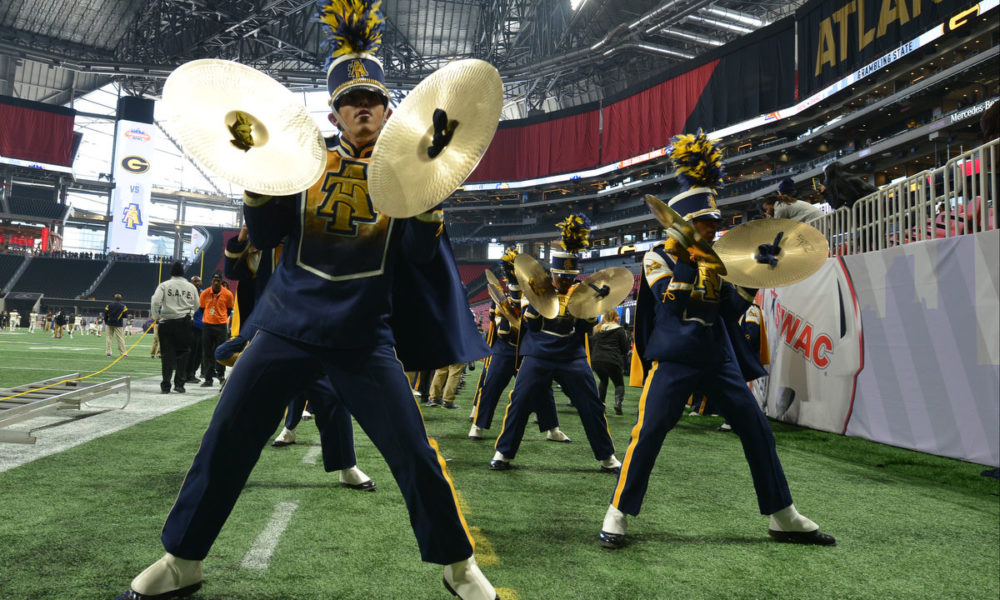It was a season of change as the DXL Frisco Bowl made its debut, the Celebration Bowl broke in a new stadium, and the NOVA Home Loans Arizona Bowl added more band performance opportunities.
 For Dr. Lane Weaver, the 2017 football season marked a special personal anniversary—20 years since he last performed as a member of the Utah State University Aggie Marching Band. On Dec. 29, 1997, Weaver was a drum major of the Aggie Band when it performed at the Famous Idaho Potato Bowl (then the Humanitarian Bowl).
For Dr. Lane Weaver, the 2017 football season marked a special personal anniversary—20 years since he last performed as a member of the Utah State University Aggie Marching Band. On Dec. 29, 1997, Weaver was a drum major of the Aggie Band when it performed at the Famous Idaho Potato Bowl (then the Humanitarian Bowl).
Now in his second year as director of athletic bands at Utah State, Weaver once again got to lead the Aggies in a series of bowl performances—including pregame, halftime, a block party, and a battle of the bands—at the NOVA Home Loans Arizona Bowl.
While the Humanitarian Bowl was in its first year when Weaver performed there two decades ago, the Arizona Bowl is now in its third year. Debuting in 2015, the bowl is quickly evolving to be a great game for fans of college band.
In the past few years, more and more bowl games have been appearing, giving college bands across the country more opportunities for post-season performance. While 2014 was a big year for new bowls—including the Bahamas Bowl, the Boca Raton Bowl, the Raycom Media Camellia Bowl, and the Quick Lane Bowl—the past two years have also seen their fair share of bowl game evolution. Many of these new post-season games have been organized by ESPN Events though some are independently hosted.
Since 2015, three new bowl games have launched: the NOVA Home Loans Arizona Bowl; the Celebration Bowl, also starting in 2015; and the DXL Frisco Bowl, new for the 2017 season.
DXL Frisco Bowl Debuts
 On Dec. 20, Louisiana Tech University and Southern Methodist University (SMU) made history as the first two schools to compete at the DXL Frisco Bowl in Frisco, TX. For the bands performing there, being a piece of that history was special. “We’ll always be one of the first bands there,” says Don Hopkins, director of athletic bands of the SMU Mustang Band.
On Dec. 20, Louisiana Tech University and Southern Methodist University (SMU) made history as the first two schools to compete at the DXL Frisco Bowl in Frisco, TX. For the bands performing there, being a piece of that history was special. “We’ll always be one of the first bands there,” says Don Hopkins, director of athletic bands of the SMU Mustang Band.
At the same time, that honor comes with a few downsides. Because the bowl is so new, organizers haven’t created as many musical performance opportunities yet. “As far as the bowl experience, it’s a little limited,” Hopkins says. “There’s a parade, a battle of the bands, or a pep rally [in other bowl games]. This one doesn’t have any of that.”
Because Toyota Stadium, where the bowl is being held, is only about 25 miles away from SMU’s campus in Dallas, many students stayed in their regular on-campus dorms the night before the game. “It’s almost like an extra football game for us this year,” Hopkins says.
After returning home for their first week of winter break, students reconvened on the morning of Dec. 20 to practice before the game’s 7 p.m. kickoff. “The last regular season game we had, the Saturday after Thanksgiving, we said, ‘We’ll do this show again if we have a bowl,’” Hopkins says.
Repeating their end-of-season halftime show allowed students to go home for winter break after their finals ended, then return to campus the morning of the game.
Regardless, the Mustang Band was excited to head to their first bowl game since the 2012 season. “We’re definitely glad to [go] to a bowl,” says Tommy Tucker, SMU’s assistant director of athletic bands. “It’s nice to be able to give the students some sort of bowl experience.”
As far as bowls go, the Mustangs have had their share of unique experiences—from spending two of their last four bowl games in Honolulu to hosting the Armed Forces Bowl in their own stadium when Texas Christian University’s stadium was undergoing renovations. Now, participating in the first-ever DXL Frisco Bowl can add to those unique experiences.
“Being a part of this first bowl, hopefully we can help them see where they want to go with the events surrounding the bowl,” Tucker says.
Much to Celebrate at the Celebration Bowl
On Dec. 16, the Celebration Bowl celebrated a new milestone: its first year in Atlanta’s Mercedes-Benz Stadium, making it the first bowl game held at that venue.
The Celebration Bowl is in its third year as a championship game between the Mid-Eastern Athletic Conference (MEAC) and the Southwestern Athletic Conference (SWAC). Prior to that, the top schools from MEAC and SWAC would play each other in a September game, called the MEAC/SWAC Challenge, to kick off the season. “It was created to give the schools from the conference a bowl-like experience because there wasn’t an official bowl game,” says John Grant, executive director of the Celebration Bowl. “That game still takes place, but with the launch of the Celebration Bowl, we’ve converted [the MEAC/SWAC Challenge] to a true kickoff game.”
This year, North Carolina Agricultural and Technical State University and Grambling State University brought their teams and bands to the Celebration Bowl. Each band performed at halftime as well as at a post-game show, known as the 5th Quarter among Historically Black Colleges and Universities (HBCUs). Bands did not perform pregame, but their 5th Quarter performances more than made up for it.
ESPN digital platform The Undefeated streamed the bands’ 5th Quarter performances online, earning about 300,000 views. Similar to a battle of the bands, each school put on a dazzling display of music and drill, trying to outperform one another for the still-packed stadium.
During halftime, ABC broadcast one song per band on TV as well. “The band experience is a big part of the entire HBCU experience,” Grant says. “It goes without question that [marching band] comes along as a part of the experience, given a bowl at championship level.”
The NOVA Home Loans Arizona Bowl Continues Evolving
Now in its third season, the NOVA Home Loans Arizona Bowl—a game in Tucson between teams from the Mountain West and Sun Belt Conferences—has been rapidly evolving. This year’s bowl, played between Utah State and New Mexico State University, featured a battle of the bands as well as a block party where the ensembles performed the day before the game.
For Weaver, traveling to a bowl game brought back memories of when he was a member of the Utah State Band 20 years ago, first as a trombone player and then as drum major. “It’s a lot more work on this side of things, [but] it’s fun,” he says. “For me to have a chance to come home and do what I love doing, the significance isn’t lost on me.”
The Arizona Bowl hardly seems that new to some of the participants. “I haven’t thought too much [about] it being a new bowl game,” Weaver says. “They’re making an effort to take care of the bands.”
One of the biggest efforts made to help the bands was having band liaisons. “We saw through the years how important liaisons were for the football teams, to have a few people who were just 100 percent dedicated to the players,” says Alan Young, executive director of the NOVA Home Loans Arizona Bowl. “That same approach [for] the marching bands would benefit both us and our operations and the bands in their enjoyment.”
Band liaisons work with band directors to organize everything regarding the bands’ itineraries, including lodging, meals, transportation, and schedule. “These people live with the band for their whole stay,” Young says. “The bands can worry about their performances. We’ll take care of everything else.”
With the band liaisons, the battle of the bands, the block party, and the bands performing at both pregame and halftime, Weaver sees this bowl as a great opportunity for his students. “This bowl is definitely evolving,” Weaver says, “and it’s nice that they’re evolving toward more band representation.”


